"Bronze collapse" or "bronze just ended"?
Third parent Kronid generation of people speaking
Copper created, nothing with the generation is not similar to the former.
With spears. There were those people mighty and terrible. Loved
Terrible affair Ares, violence. Bread did not eat.
Stronger than iron was their mighty spirit. No one approach
He did not dare to them: they had great power,
And neoborny hands grew on the shoulders of powerful.
They had copper armor and copper dwellings,
Copper work done: no one knew about the iron.
A terrible power of their own hands brought them destruction.
All descended namelessly; and, no matter how terrible they were ...
Hesiod "Works and Days"
We have completed the publication of materials on stories Minoan civilization, written, so to speak, "without delay". But the interest in the topic turned out to be so great that it became necessary to expand it and to consider several other important issues directly connected with it. In particular, this is the question of the death of the Minoan civilization of Crete, which was due to a catastrophe, the consequences of which made the island vulnerable to external invasion. However, the end of the Minoan civilization was, in fact, the end of the whole Bronze Age. Rather, these two events coincided surprisingly in time. Such coincidences in history happen all the time, but what happened there after all? There was a ... "bronze collapse" - say archaeologists and historians who call this term the transition from the Bronze Age to the Iron Age, which occurred almost simultaneously in the states of the ancient Middle East and Eastern Mediterranean (in Levant, Asia Minor and Greece). Here, the change of epochs turned out to be connected with truly catastrophic changes both in the public order and affected the loss of many technological skills and cultural traditions, such as writing. There was a destruction of all large state formations, not to mention the cities. In Europe, the period of the first "dark ages" began (in Greece they are known as the "Greek Dark Ages").
Bronze cast sword replicating earlier designs with wooden handle. (Museum of Lyon, France)
Chronologically, all these sad events took place in 1206 — 1150. BC er It was then that the invasion of the "peoples of the sea" occurred, the Mycenaean kingdom perished, the Hittite state on the territory of Anatolia and Syria, and the domination of Egypt in Syria and Canaan also ended, although the Egyptian state itself stood. Mycenaean linear writing and Luvian writing disappeared. Almost every city between Troy and Gaza was destroyed and after that, after that, it was no longer settled: for example, such cities as Hattusa, Mycenae, and Ugarit were abandoned forever.
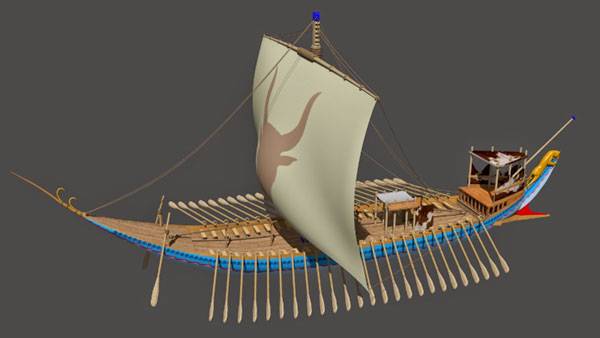
Model of the ancient Minoan ship.
The catastrophe that took place during this period led to very serious regressive phenomena in almost all spheres of spiritual life and in the field of material culture. The art of shipbuilding, architecture and architecture, metalworking technology, weaving, and especially painting were thrown back at once centuries ago and were revived only a thousand years later, in the era of the late Greek archaic. For example, the myth of the death of King Minos in the bath as a result of boiling water supplied by the king of Sicily was considered a perfect invention even in the Hellenistic era, since in the Mediterranean only in Rome of the empire did pools appear that had separate pipes for hot and cold water. It was simply impossible to think about this before, although the Cretans knew how long ago. The palaces of Knossos and Festus in several floors and the stone houses of the townspeople, equipped with sewage systems in the cities on the island of Santorini and on the Ionian Islands, all this seemed to fall from the history and consciousness of the people of that time.
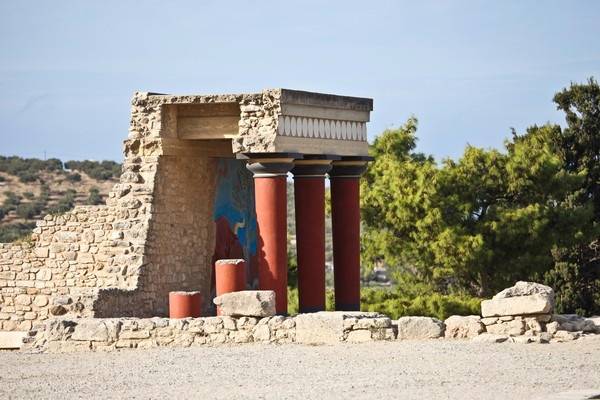
Palace in Knossos. North entrance. Reconstruction of Arthur Evans.
In every major Hittite city, a layer of destruction dating back to the end of the Bronze Age was found, and the Hittite civilization, as archeologists find it, was unable to return to the previous level that preceded this catastrophe. By the way, ancient Troy, too, was destroyed at least twice, and only then it was finally abandoned, so only the Romans built their city on the same hill.
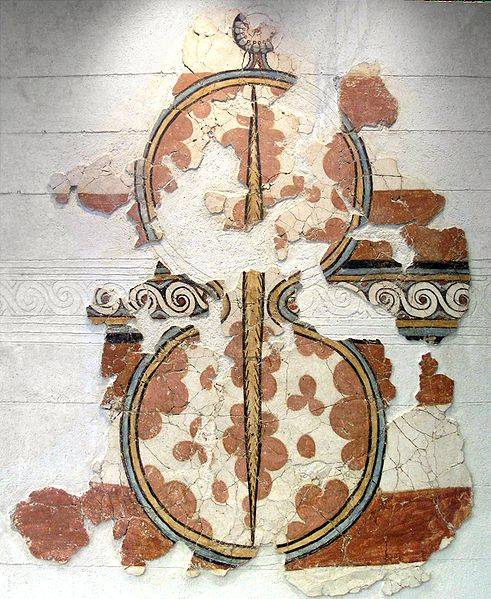
Eight-shaped shields - painting of the palace at Knossos, Kollonad Hall.
In Cyprus, the cities of Enkomi, Kition and Sinda were captured, plundered, and then burned, and again, sometimes twice, after which people left them completely. In the city of Kokkinokremos found many treasures of metal products. But once they were found by archaeologists, this clearly indicates that the owners of these treasures did not return for them. At the same time, the “bronze collapse” in Cyprus led not to its decline, but to the opposite - to its flourishing, which then continued until the X century BC. er That is, it may very well be that Cyprus, rich in deposits of copper, has become a kind of "base" for the "peoples of the sea." And it was from him that they made their raids into the Levant, and then brought the stolen loot here.
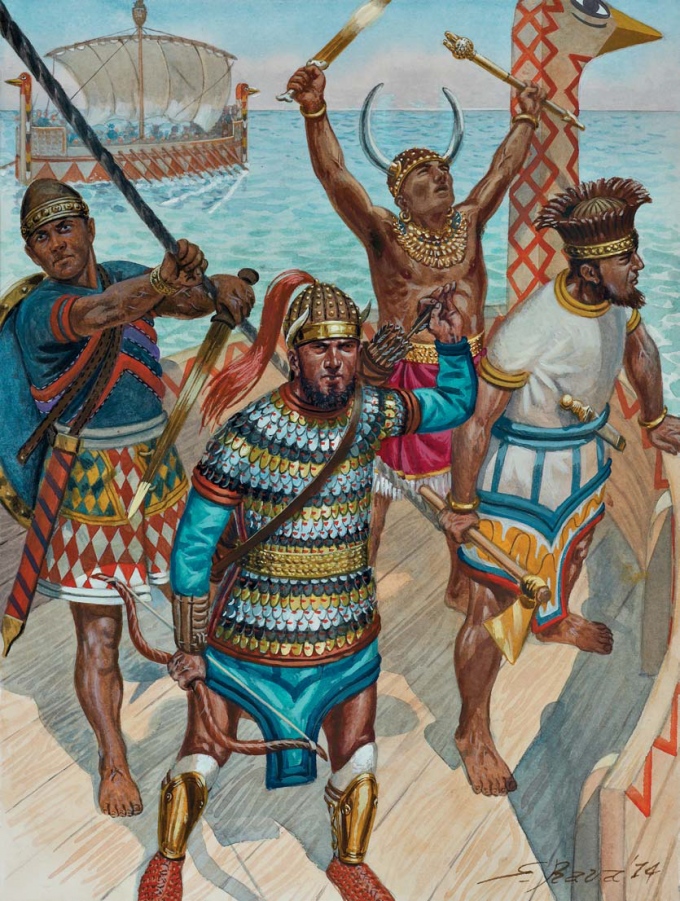
Perhaps it looked like the warriors of the "peoples of the sea", which brought so much trouble to the civilizations of the Ancient East. Artist J. Rava.
Excavations of the city of Ugarit show that massive destruction occurred after the reign of Pharaoh Merneptah. The texts on clay tablets that were burned by the fire that raged in the ruined city speak of invasions from the sea, cities that had already been destroyed by the “peoples of the sea”. One of the texts has a message about the absence of Ugaritic fleetwho was busy patrolling the coast.
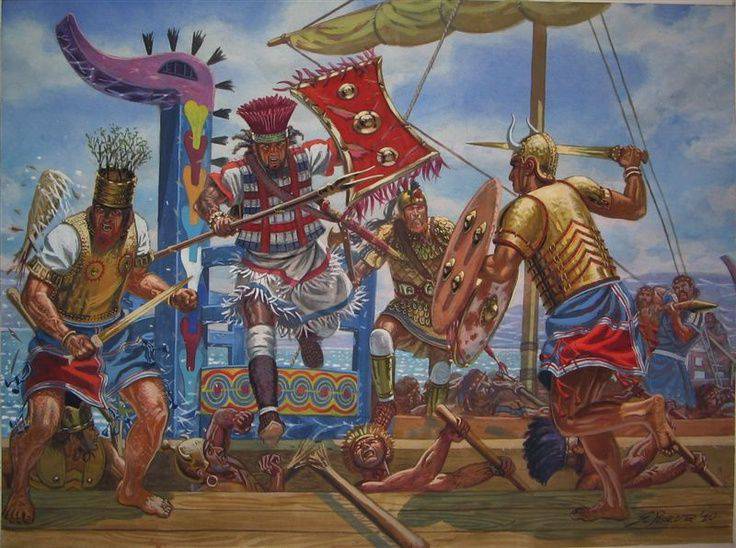
Pharaoh's sherdins fight the Philistines. Artist J. Rava.
By the time of the coup of Horemheb for Egypt, nomadic Shasu became an increasingly serious threat. Ramses II, after the epochal battle of Kadesh, began a war with them. Egypt and its heirs Egypt defended, but the cities of Ashdod, Ashkelon, Acre and Jaffa were destroyed and more than thirty years were empty.
People of the Minoan era loved to adorn themselves ...
... But what's the point in these decorations, if you have nothing to eat, or do enemies come from the sea that you cannot repel? (Heraklion Archaeological Museum, Crete)
In Crete, from the Mycenaean palaces, the catastrophe of the Bronze Age also could not survive one. In the Peloponnese, 90% of settlements were destroyed. What about people? People died! Then came the “Greek Dark Ages,” which lasted more than 400 years. Sociologists define age as the life of three generations. Since at that time life expectancy was less, it is unlikely to be a mistake to consider that century for four generations. That is, during this time, 16 generations have changed. That's how long it took to return to the previous level of culture. A new rise began only in the era of geometric ceramics.
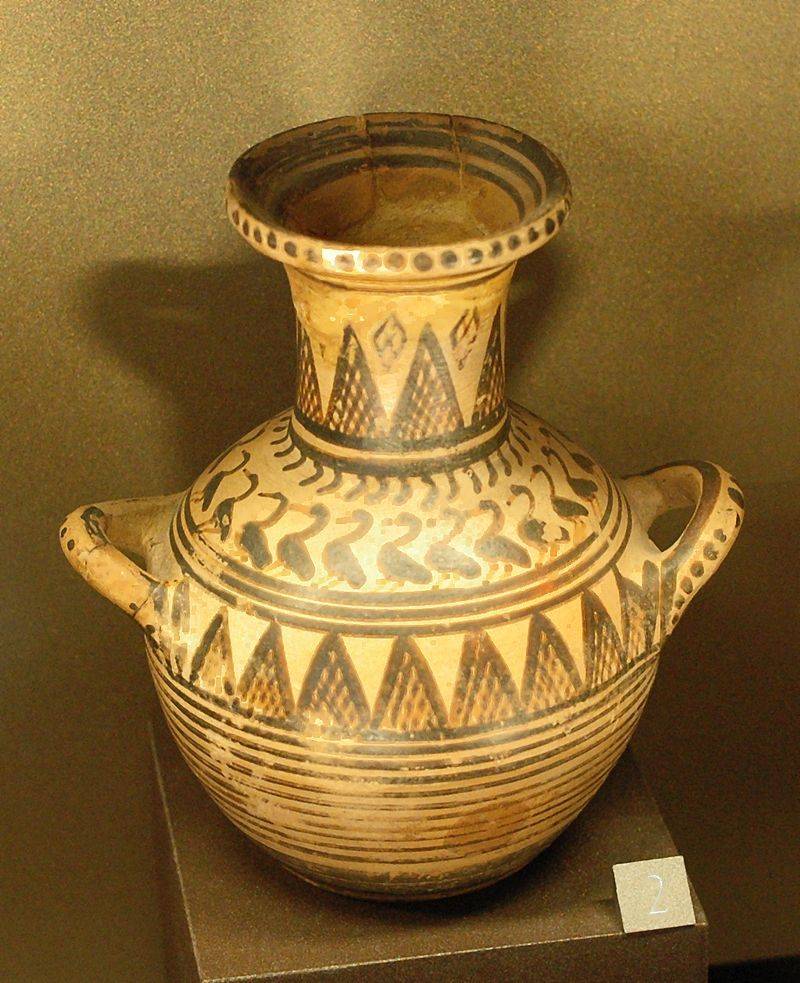
Hydria in the style of geometry. 750 — 700 BC er (Louvre)
The indigenous population of Crete escaped from the raids of "the peoples of the sea" high in the mountains. It was difficult to get there, it was easy to defend there, but just living there was very, very uncomfortable.
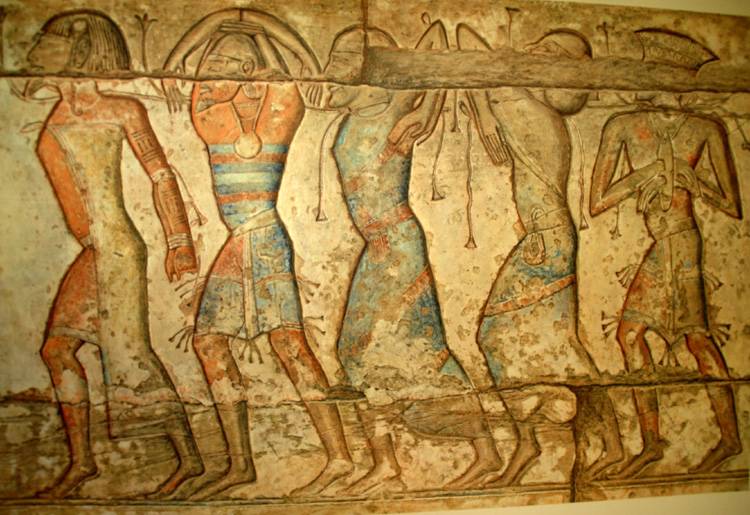
Reliefs in the temple of Medinet Habu in Egypt. From left to right: captive "peoples of the sea" - lab, shekelesh, Canaanites and pelesets.
The Assyrians, however, were able to fend off the invasion of the fly under Tiglatpalasar I. But both Assyria and Babylon had to be very hard. In addition, Babylon also suffered - it was plundered by the Elamites led by Shutruk-Nakhunt, after which it lost its significance for a long time.
Another Egyptian relief depicting the sea battle of the Egyptians with the "peoples of the sea."
In Egypt, the "peoples of the sea" invaded through Libya. In their composition were Achaeans, Sikules, Lycians, Sherdens (or shardan - perhaps Sardinians?) And Tyrsens, after which, under Ramses III, a new attack of the Philistines (Pelasgov?), Checker (Tevkrov?), Sherdin and Danai followed.
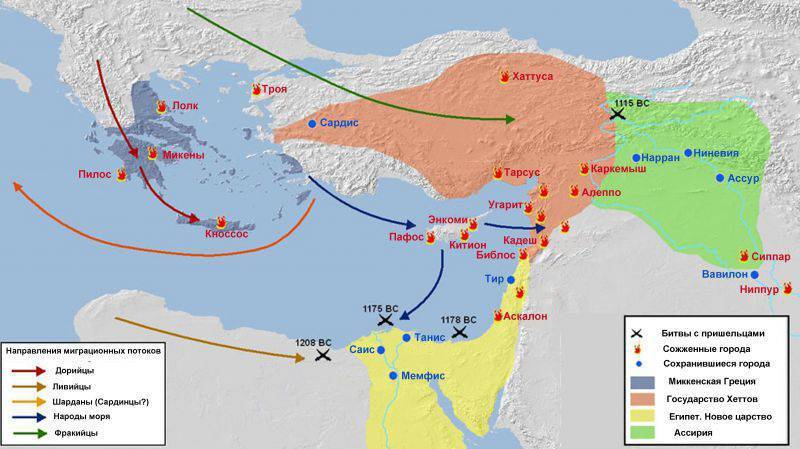
Map of migrations of the peoples of the Mediterranean in the era of "bronze collapse." Fig. A.Shepsa
It is clear that the memory of such a terrible tragedy in the memory of people is preserved, although it was sufficiently subjected to mythologization. A number of ancient authors reported the time before this catastrophe as a lost “golden age”. For example, Hesiod wrote about the epochs of the Golden, Silver and Copper centuries, as about heroes separated from his cruel Iron Age.
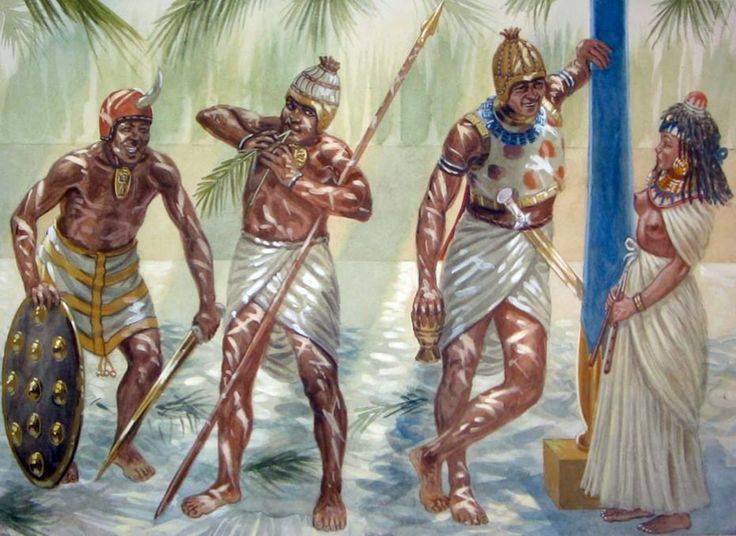
Warriors at all times loved to flirt with pretty women! Artist J. Rava.
There are many points of view regarding the possible causes of "bronze collapse." These are, for example, the superpower eruption of the Hekla volcano, dated 1159 g. e., although a number of archaeologists consider it to a later time.
The area of the Aegean Sea during a volcanic eruption on the island of Santorini. Fig. A.Shepsa
Harvey Weiss, a specialist in Middle Eastern archeology from Yale University, studying droughts in Greece, Turkey and the Middle East, counted it was a long-term drought, which sharply worsened the socio-economic situation of the whole region, the cause of inevitable wars and migrations. This is quite consistent with those ancient Greek sources that report a severe drought, which began shortly after the Trojan War.
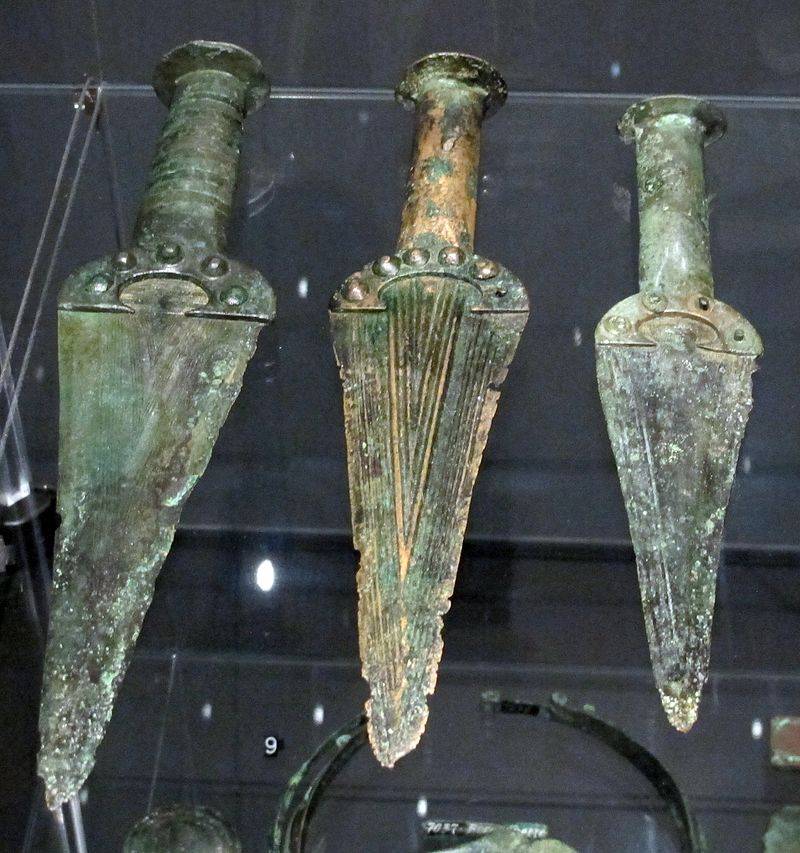
Bronze daggers 2200 - 1600's. BC. (Museum of Lausanne)
A number of scientists, considering the revealing finds of many swords of the type Naue II from the south of Eastern Europe, and the Egyptian and Ugaritian reports of the invasion of the "sea peoples", see in migrations the main cause of the catastrophe that occurred. Not without reason, soon after the reign of Pharaoh Ramses II, the Egyptians built several fortresses along the Libyan coast precisely in order to resist the "sea peoples". However, what caused this migration? Primitive greed for "old" and rich nations? Was the traditional desire of the poor from the rich to “take away and divide everything” or were there any deeper, perhaps hidden reasons from us?
Mold for spearheads, approx. 1400 - 1000 BC (Somerset, County Museum)
The “iron concept” of Leonard Palmer, for example, says that since it was at this time that iron metallurgy was discovered, and it was more accessible than bronze, then the army with iron weapons able to defeat armies using bronze weapons and chariots, although iron weapons were initially of inferior quality. However, over time they began to believe that the final transition to iron tools and weapons took place already after the "Bronze Age catastrophe" ended. That is, not iron itself was the cause of the "bronze collapse."
Foundry mold for casting bronze sword, approx. 800 BC Württemberg, Stuttgart.
Could bronze production be reduced by reducing the supply of tin? Yes, it could. But why? Were exhausted tin mines or something else happened? Most likely, it was the systemic collapse that affected not only the Eastern Mediterranean. In Central Europe, too, a noticeable regression can be observed between the culture period of the burial urns of the thirteenth and twelfth centuries. BC er and later Hallstatt culture in the X — IX centuries. BC er - that is, time synchronous "Greek dark ages", which began after the collapse of the Mycenaean civilization. But then again, what caused the crisis in several systems of the then society at once?
Bronze swords from the National Museum of Copenhagen.
There is a purely military point of view of historian Robert Drews, who believes that new types of weapons and armor, in particular cast (and not forged) spear tips and long piercing-cutting swords of the Naue Type II type, which appeared in the Eastern Alps and Carpathians around 1200 before n e., led to the emergence of mass armies, supplanting the army of professional soldiers with piercing swords, rapiers. And then the bronze was completely replaced by iron (without changing the design of the sword itself). Homer often uses the word "spears" as a synonym for the word "warrior", that is, it was this weapon that at that time began to play the main role in the war.
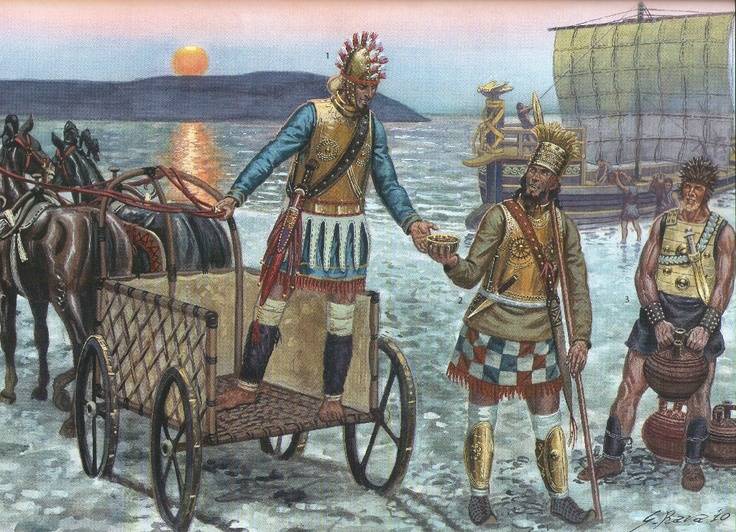
Warriors in chariots gradually lost their former role ... Artist J. Rava.
These weapons began to be used by proto-hoplites, which were now able to successfully repel the attacks of the war chariots, and this they crushed the armies of the former slave-owning states, whose military power was based precisely on the use of war chariots. As you can see, there are plenty of hypotheses, but how it was actually said, of course, no one will undertake, for a very long time it all happened!
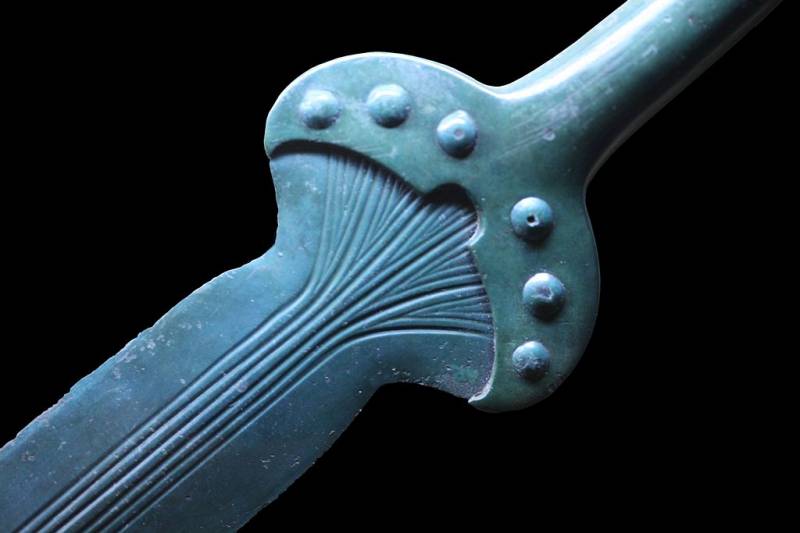
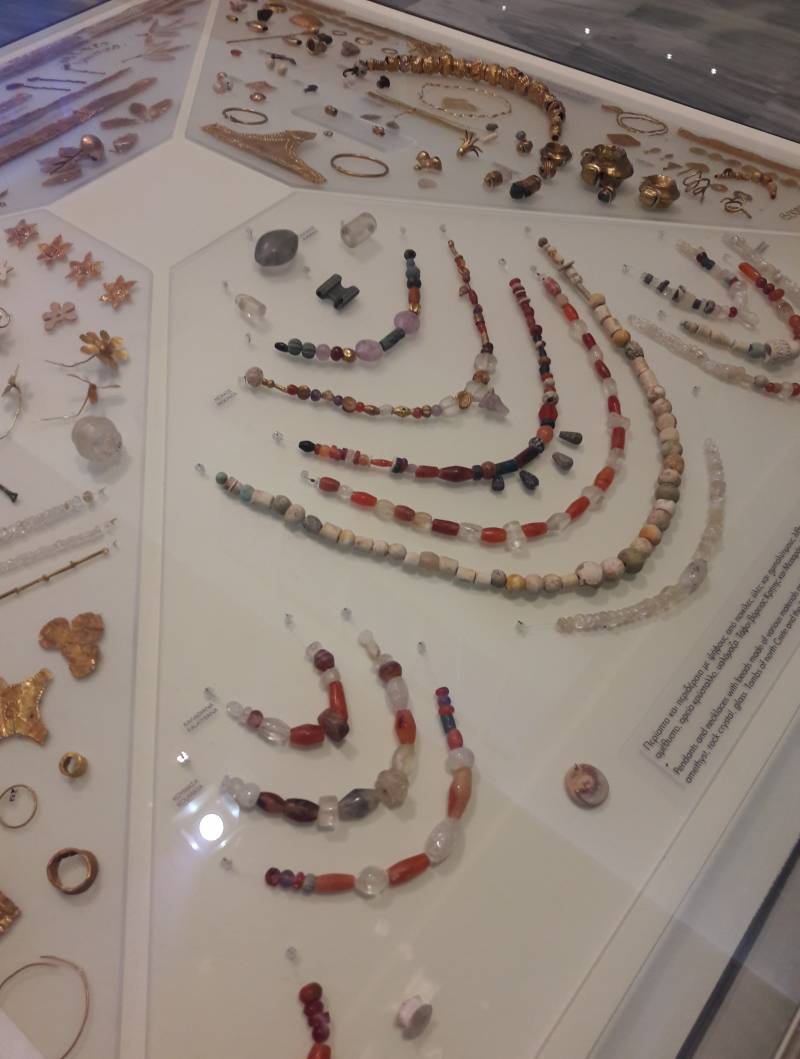
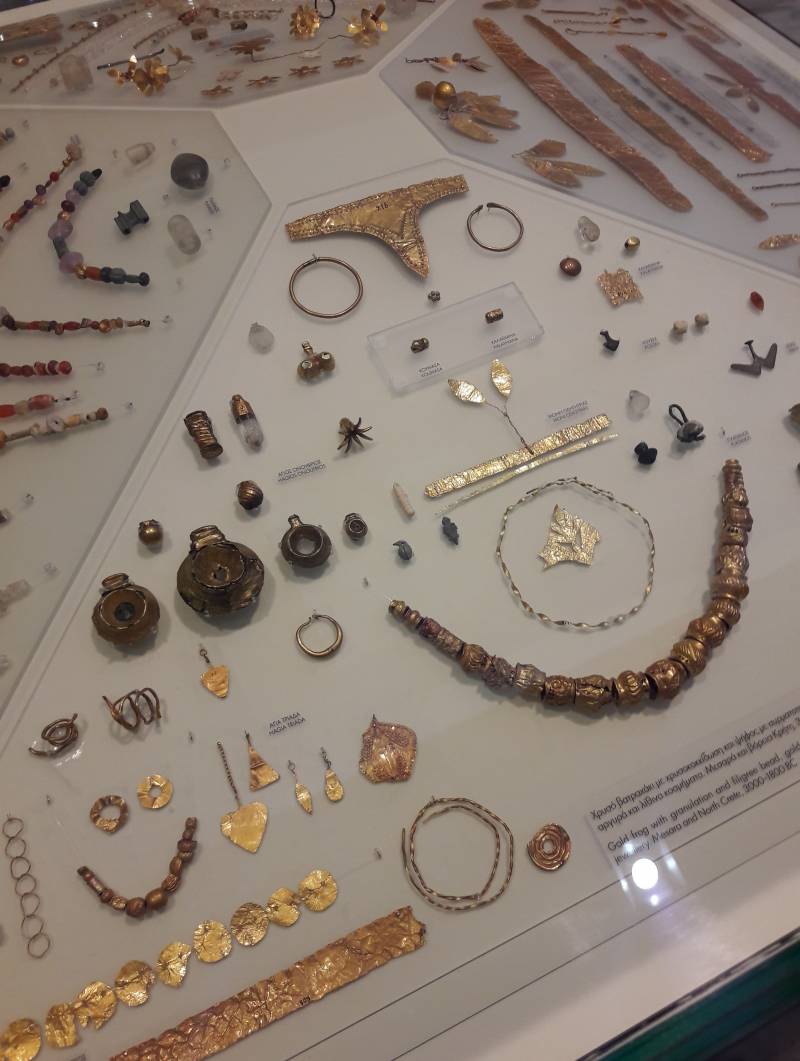
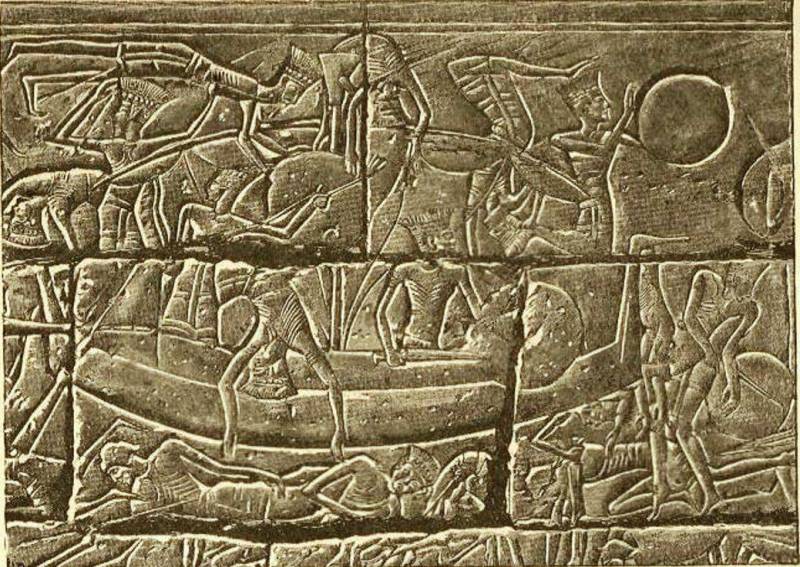
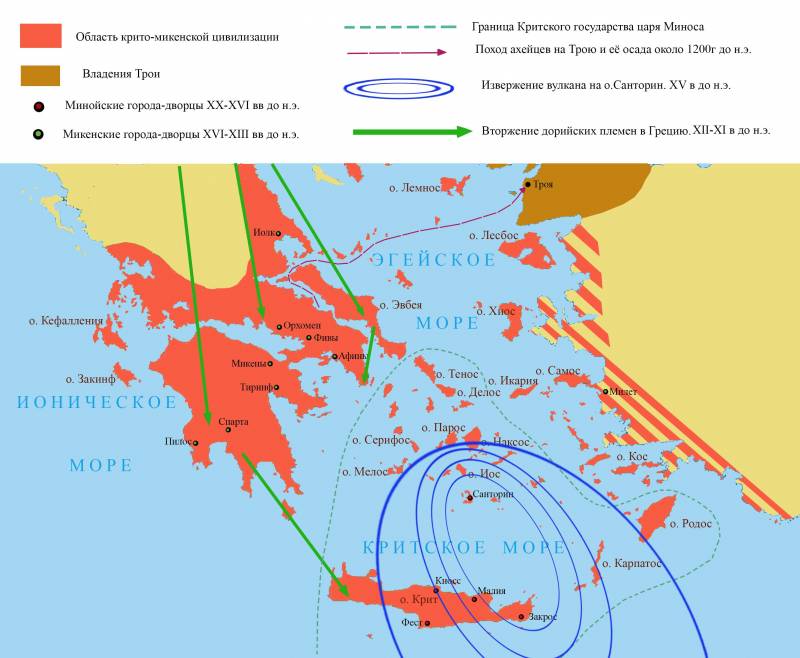
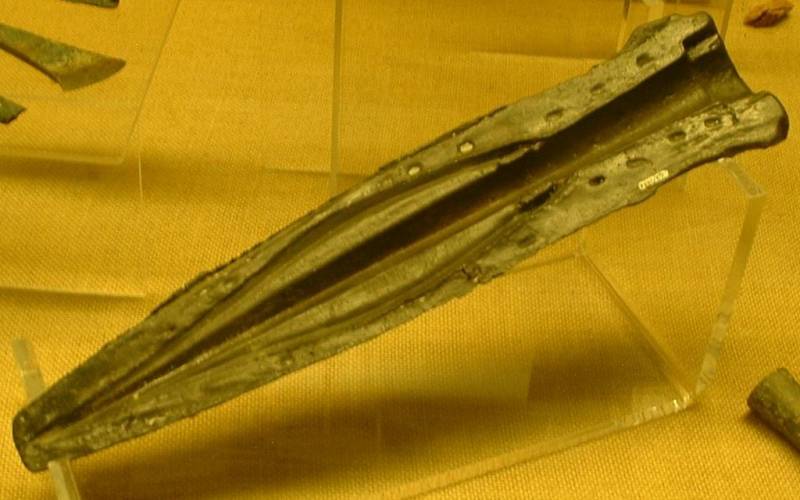
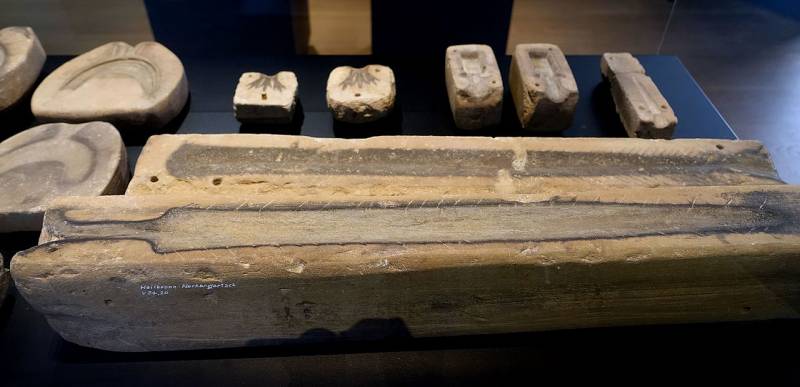
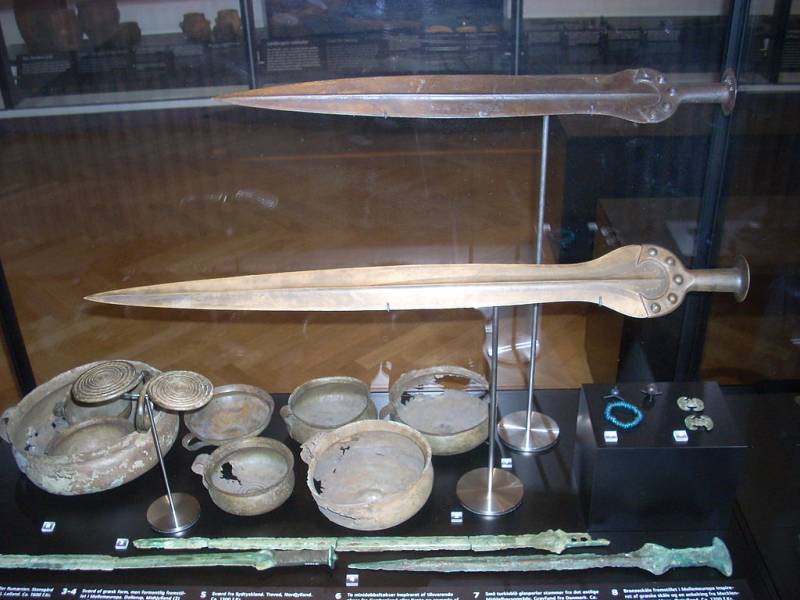
Information